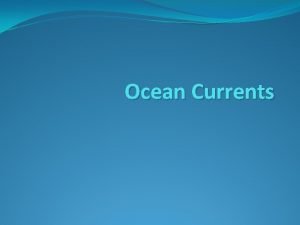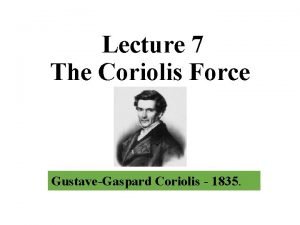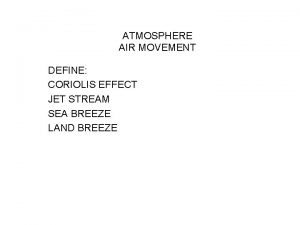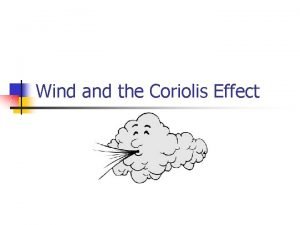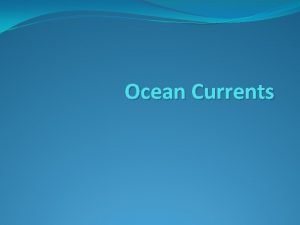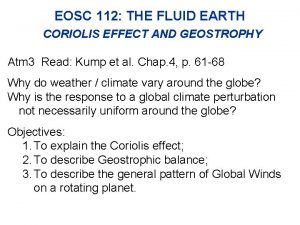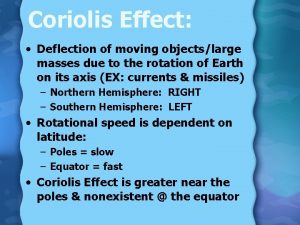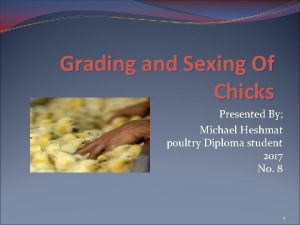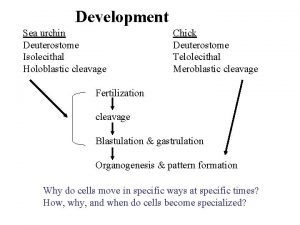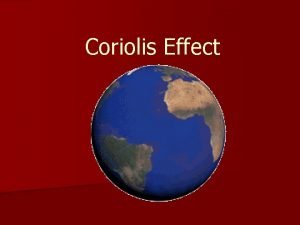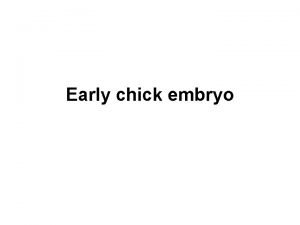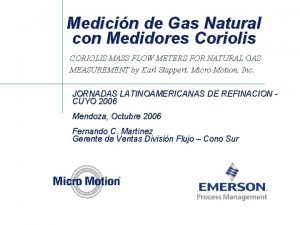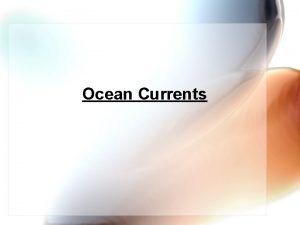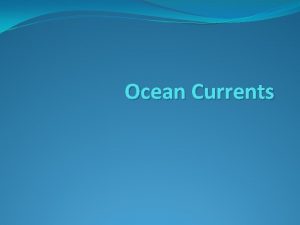The Coriolis Effect Elliott Chick Current University of


















- Slides: 18

The Coriolis Effect Elliott Chick Current University of Exeter MPhys Undergraduate

What is it? �The Coriolis effect is the apparent deflection of an object in a rotating reference frame. �Gaspard-Gustave Coriolis was first to consider this supplementary force. �When Newton's laws of motion are applied in a rotation frame of reference, other forces appear. �These forces are “Fictitious forces” and are used as correction factors for the simple application of Newton’s laws in a rotating system.

Newton's Laws in a rotating reference frame. �

Newton's Laws in a rotating reference frame. �

The Coriolis force �

An example… • One of the Coriolis effect’s most common appearance is in ballistics. • Target: Ciudad Real Madrid 40. 479167 N, 3. 611667 W • Distance from Physics Building: 1141 km • Tomahawk missile • Average speed = 244. 4 m/s (sub sonic) • Effective range = 2500 km • ω of earth = 7. 27 x 10 -5 rads/s (http: //toolserver. org/~geohack/geohack. php? pagename=Ciudad_Real_Madrid¶ms=40_28_45_N_03_36_42_W_type: landmark) (http: //www. nhc. noaa. gov/gccalc. shtml) (http: //en. wikipedia. org/wiki/Tomahawk_(missile)) (http: //hypertextbook. com/facts/2002/Jason. Atkins. shtml) http: //www. europemapofeurope. net/europemap-of-europe-large-2008 -muck-hole. jpg

An example… �


The Experiment �The aim of this experiment was to demonstrate the Coriolis acceleration in a rotating reference frame, and showing that the Coriolis acceleration is proportional to the angular velocity of the rotating reference frame. �Apparatus used: (From experiment ME 06) �Glass turntable (Connected to DC power supply) � Covered with paper �Metal ramp �Ball bearing

Experimental setup

Experimental method �Find the velocity of the ball bearing �Time taken to travel between 2 points �Measure the angular frequency of the turntable �Measure amount of rotations and time taken, use rotations/time to work out revolutions per second �Multiply by 2π to find the angular frequency of the turntable

Experimental method continued �Coat the ball bearing in a layer of ink �Place on ramp, with quick release in place �Start up the turntable �Release the ball �The ball will leave behind a trail of dots, allowing easy observation of the path of the ball

Analysis �

Results 1 0. 2 Demonstration of repeatable results for ω = 1. 2 rads/s 0. 18 0. 16 Displacement (m) 0. 14 0. 12 0. 1 0. 08 0. 06 0. 04 0. 02 0 0 0. 05 0. 1 Time (s) 0. 15 0. 25

Results 2 0. 5 ω = 1. 2 rads/s 0. 4 Velocity (m/s) 0. 3 0. 2 0. 1 0 -0. 05 0 -0. 1 0. 05 0. 1 Time (s) 0. 15 0. 2

Results 3 0. 9 ω = 1. 67 rads/s 0. 8 0. 7 Velocity (m/s) 0. 6 0. 5 0. 4 0. 3 0. 2 0. 1 0 -0. 05 0 -0. 1 0. 05 0. 15 Time (m/s) 0. 25 0. 3

Results 4 ω = 0. 55 rads/s 0. 35 0. 3 Velocity (m/s) 0. 25 0. 2 0. 15 0. 1 0. 05 0 -0. 05 0. 15 Time (s) 0. 25 0. 35

Conclusions �The Coriolis effect can be easily proven using this experimental method �From my results I can see that the Coriolis acceleration is proportional to the angular velocity of the rotating reference frame. �The velocity was kept constant, thus the only factor effecting the Coriolis acceleration was ω showing its proportionality.
 Coriolis effect vocabulary
Coriolis effect vocabulary Coriolis effect formula
Coriolis effect formula Define coriolis effect
Define coriolis effect The coriolis effect provides evidence that
The coriolis effect provides evidence that What is coriolis effect caused by
What is coriolis effect caused by Coriolis force effect on ocean currents
Coriolis force effect on ocean currents Hadley
Hadley Deflection
Deflection What is coriolis effect caused by
What is coriolis effect caused by Quizzes
Quizzes Penguin chick main idea and details
Penguin chick main idea and details Syllables v/cv vc/v penguin chick
Syllables v/cv vc/v penguin chick Chick-fil-a organizational structure
Chick-fil-a organizational structure Vent sexing chicken
Vent sexing chicken Amelia a. erwitt
Amelia a. erwitt Chick embryo 48 hours diagram
Chick embryo 48 hours diagram Dignified connotation
Dignified connotation Chick-n-gravy dinner line case study
Chick-n-gravy dinner line case study Yrdsb career cruising
Yrdsb career cruising
